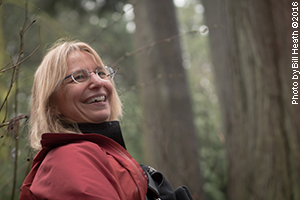
You have conducted three decades of research into the ways trees connect and communicate with each other via mycelial networks. Let’s start at the beginning. Your PhD thesis in 1997 revealed that Douglas fir and paper birch trees were using mycelial networks to send carbon to each other. Before that study was published, and before the 1993 study by Kristina Arnebrant and others in Sweden which showed that alder and pine were exchanging nitrogen-based nutrients through a shared mycorrhizal network, what was generally known about the relationship between trees and fungi
People have known for hundreds of years that there was some kind of below-ground association between trees and mushrooms, but they did not fully understand what that association was.
Different kinds of fungi perform different jobs within their ecosystems. Some are saprophytes, some are pathogens, and some are mycorrhizae. Mushrooms were observed doing all of those things. However, it wasn’t until 1885, when a German scientist named A. B. Frank wrote a paper about the evolution and ecology of mycorrhizae, that the mutualistic, beneficial symbiosis between mycorrhizal fungi and plants was formally understood. After that, people started looking at how carbon might move through mycorrhizae and ecosystems. In 1960, a Swedish botanist named Erik Björkman labeled pine trees with carbon-14 and was able to trace that carbon-14 into mushrooms and other plants that were surrounding those trees. In the early 1980s, David Read, a scientist in the UK, took that one step further. He and his graduate students built a laboratory experiment. They grew grass seedlings in one experiment and pine seedlings in another, and inoculated them with a mycorrhizal fungus. That fungus grew a network between the seedlings. Just as Björkman did in the field, Read and his students labeled one plant with carbon-14, and they were able to trace the movement of carbon-14 to the neighboring seedling. Read used a method called “radioaudiographs,” where he took a picture of the radioactivity within the network. One of Read’s main students involved in this work was Roger Finley. Kristina Arnebrant, who you mentioned in your question, was Roger’s student. These scientists were all brought up by each other. That’s a long preamble to where we are right now.
When and how did you first become interested in this connection between fungi and trees?
I grew up in the forest so I always knew that forests were complex places. To me, the different plants, tree species, animals, fungi, and bugs were this amazing community that worked together. They all had their different roles, but to me, they were inseparable. But when I started studying forestry and working in the forest industry, I noticed that we were managing forests as though they were just a bunch of trees. I always say that the whole is greater than the sum of its parts, yet we manage the forest as though it is just a bunch of parts. I was doing basic silviculture back then, trying to figure out how to get trees to grow better, and trying to understand why a managed forest looked so different from an old growth forest. In my mid-20s, I worked for a forester in the B.C. Ministry of Forests named Alan Vyse, who recognized my curiosity and encouraged me to do research in the forest. That ultimately led me to ask the question, “What is going on below ground?”
When it comes to sharing nutrients between tree species, are there other known tree pairings or partners, besides alder/pine and fir/birch?
People have been looking at mycorrhizal associations for a long, long time. In the 1980s, long before I started looking at birch and fir, people were documenting what kind of mycorrhizal fungi species were associated with different tree species. It was already known that certain fungi were generalists that could associate with many tree species.
Since then, there has been a lot of work done using molecular techniques to verify that these shared associations indeed exist. If I look at the forests here in British Columbia, I know enough from the basic literature on fungal associations with different tree species that most of our trees have the potential to be linked up into a network. It’s not just birch and fir; it’s everything. Almost all tree species–alder being an exception–have a suite of many fungi. Alder fixes nitrogen in the soil, a nutrient needed by many plants including trees, and it just has very few fungal species in its roots, sometimes only one. Some of the fungi are specific to tree species, but many are generalists, which can form networks with multiple tree species. Based on the basic understanding of these associations, I think there is high potential for linkage between many species of trees.
Your more recent research has shown that trees are sharing much more than nutrients with each other. Can you describe how trees share defense signals? How were you able to measure/determine this in your research?
Yuan Yuan Song [of Fujian Agriculture and Forestry University in China], the lead author of a paper on tomato plants communicating threat signals through mycorrhizal networks, contacted me to see if she could work with me in our conifer trees to see if this signaling was going on between trees. She came and did a postdoc with me. We found similar responses; our work showed that defense responses were shared among tree species that were linked together by a mycorrhizal network. If one of the tree species was injured (we plucked off needles or infested the plant with a spruce budworm), when we harvested the neighboring plant and looked for defense enzyme responses and gene regulation, we found that networked plants were upregulating their defense genes and increasing defense enzyme production, which made them more resistant to the damage. This did not happen with plants that were not linked by a mycorrhizal network.
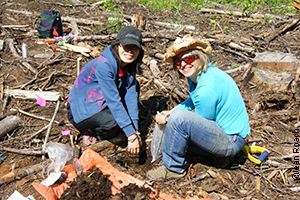
Yuan Yuan Song & Suzanne collecting soil samples
We haven’t precisely identified what the signals are, but we have some guesses. Yuan Yuan’s work with tomatoes and other plants has pointed in the direction of certain compounds that are known to activate defense responses within plants. She was looking at methyl jasmonate and salicylic acid. A graduate student and I did subsequent work focused on methyl jasmonate specifically. We found that there was signaling being shared among linked plants, but we could not definitely say that methyl jasmonate was the signal that was moving across. There has not yet been that perfect study to really pinpoint what it is, but based on the evidence we have so far, we are strongly suspicious that it is methyl jasmonate.
What other types of plants communicate threat signals? Shrubs? Grasses?
That’s a good question. There has been work done in the UK by Dave Johnson and Lucy Gilbert, who have been looking into this concept with broad bean (Vicia faba) plants infested with aphids. The aphids had a parasitoid that was activating them, and the plants were communicating with other plants of the same species through mycorrhizal networks. (Ecology Letters (2013) 16: 835–843) I do not know if anyone has worked with grasses.
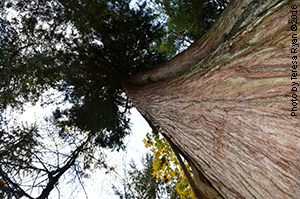
Mother tree western red cedar in Vancouver-culturally modified 100 years ago by Aboriginal bark stripping and healed
Tell us about “Mother Trees.” What are they? How do they contribute to the health of forest ecosystems?
Mother trees are really just the biggest, oldest trees in the forest. These special, dominant trees have huge root systems, so they have lots of potential for connecting with other plants. Our work started to reveal that not only were these trees sharing nutrients, but the survival rate of seedlings planted around the mother trees would increase by two to four times. That’s why we started calling these dominant trees mother trees; it seemed like they were nurturing these young seedlings. It’s a term we made up as we were trying to express what we were finding so that people could relate to it.
When you’re walking in a forest, the mother tree is that big, old tree. But if you have a forest where there are no big, old trees left, smaller trees will take on the role of the mother tree. Think about your own networks. There are key people in our social networks who are linked to everybody else. It’s the same in the forest. Those big, old trees become those key hubs. But say that key networker friend moves to another town, and suddenly there is a gap in that friendship circle. Someone else will move in to fill that role. The same is true in the forest: if a mother tree is killed or logged, other trees still form networks.
Let’s go back to that “big, old tree” that might be logged or killed. I understand that dying trees still contribute to the forest, and use mycelial networks to pass on ‘wisdom’ to younger trees. What is that wisdom, and how do they pass it on?
In our defense signals study, this “wisdom” was something else Yuan Yuan Song and I looked at. I call it wisdom because it is something more than just chemicals and I don’t completely understand it. We found that while the trees we injured were dying, they transferred a whole bunch of their carbon into the network that was taken up by the neighboring tree. That carbon is likely in a constellation of compounds including amino acids and sugars. Those dying trees were sending carbon directly to their neighbors. If that carbon were not sent directly to neighbors, it would be dispersed to the general ecosystem: it would leak out of the root tips, or the tree would slowly fall apart and be chewed up by different saprotrophic fungi or soil organisms as part of the decay process. That energy is then dispersed in non-directed way. But through the network, the trees can actually focus the transfer of their energy to individual plants. I call that wisdom because it’s a process that we have never really understood before.
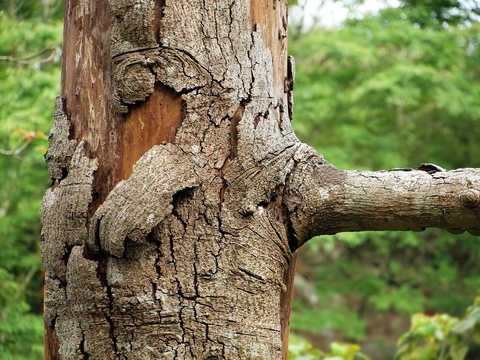
Were you able to measure the speed with which the carbon was transferred?
Within 24 hours, the carbon starts to move over. It may well be faster than that, but we did not look at a finer time scale. Yuan Yuan Song’s work showed that the defense signaling transfer occurred within six hours. I think that the defense signals and the carbon transfer are linked together, so I wouldn’t be surprised if it happened within hours.
Many of our readers are practitioners of ecological restoration projects, and while they aim to minimize disturbance, the construction phases of these projects can involve disturbing the soil and some tree removal. When practitioners mark trees for preservation (based on size and health), how can they know which trees may be mother trees? What advice do you have for them based on what you have learned about the relationships between trees and mycorrhizal fungi?
Many good things can be done with this knowledge. Say you’re trying to restore an ecosystem around some existing trees. One of the things you can do is know which fungal communities are favored by different tree species, and then try to favor or plant the species that make the most sense. For example, here in the Pacific Northwest, western red cedar and maples form a particular group of mycorrhizal fungi called arbuscular mycorrhizae. If you were trying restore a forest in which people had cut everything down but cedar trees–and people actually do that out here—one species you might want to introduce would be a maple. You can match up trees according to their below-ground associates.
Many people may be a lot less familiar with fungi species than tree species. How can they learn more about which fungi species are good below-ground associates of certain tree species?
Many papers have been written about this, but they may not be very accessible to the general public. About ten years ago, the U.S. Forest Service spent quite a bit of effort trying to get out publications about tree/fungi species relationships out to the public, and they may still be available. Because there is more interest in this topic now, I think there is an opportunity to make this information more publicly available. Of course it depends on what type of trees and fungi are local to the area, the soil, and precipitation – the usual forest conditions. There’s a website in the UK called Trees For Life and the International Mycorrhiza Society.
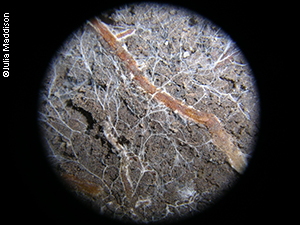
Mycelium in the soil
Getting back to your advice for practitioners…
One mistake made in restoration that can easily be avoided involves soil removal. You can accidentally remove so much of the soil community that it prevents you from establishing the tree species you want to establish. If you cut down all the trees in the forest, and then replanted a suite of trees associated with different fungi, those trees might not succeed, because they cannot link into the existing mycelial network. If they do succeed, that soil community will eventually completely change. Then, if you later want to change that community back to the original forest, that is very hard to do because you have changed the whole below-ground community. So first, you really need to know the native tree and fungal species, and know whether what you are doing is going to disrupt that community. If it is, try to avoid that. But this type of disruption happens all the time, particularly in urban areas. In those cases, taking top soil from an original site and putting it back in works very well.
When you salvage and reintroduce soil that way, would you want to inoculate it with mycorrhizae?
We are experimenting with transplanting soil that includes the mycorrhizae, but you can also purchase inoculum of generalist fungi that you can add to your soil to help your seedlings become colonized. There are different options available.
People will often plant a tree without knowing that the soil has the wrong microflora. The tree might hang on for a year and die. That’s a very good reason to look below ground and see what’s happening. What can you add to the soil to make that tree species survive? Can you switch out the tree species so that it’s more compatible with the soil community?
Your research showed that mother trees show preference to ‘kin.’ What implications might this have for practitioners who are specifying seed mixes for a restoration project?
People have been looking at kin selection in animals for a long time, and in recent decades, with plants. Most of the early work was done with clonal plants, and it showed evidence of kin selection. Plants with the same genotype influenced each other’s growth. We wanted to find out if that was going on in forests, and we found out it is. We found that a tree will send more carbon through its network to kin seedlings than to non-kin seedlings. We have found this in three or four experiments now, so it’s real.
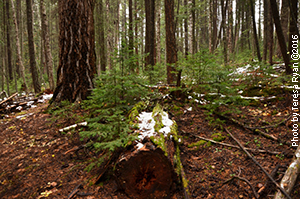
You may ask, how can we use this information? If kin can communicate with kin, is there something going on in the ecosystem that we should be trying to encourage?
In forestry, we focus on making sure there is a diversity of seed/genotype, so we have a genetically diverse ecosystem. Generally, that is a good thing. But our research shows there is also something going on among kin. This fits in with a lot of First Nations’ world view. They will always find and collect seed from trees growing on the site, and then reintroduce those seeds back to the same site. They understand there is a kin recognition going on based on their own observations. For them, the implication of my research is “Of course. We’ve been doing that all along.” But most of us in forestry don’t practice that at all. To take advantage of this biological effect, I would advise that we encourage natural regeneration of trees in the project area. Instead of, or in addition to planting new trees, encourage the trees that are already on the site to set seed and reproduce around themselves.
Paul Stamets said that soil disturbance is good for mycelial networks, as it stimulates growth. Do you have any advice in terms of considerations for these networks when accessing sites, grading, etc.?
The most important thing is not to take the forest floor or original soil off the site. You can move it around and disturb it; that’s okay. If you completely remove the plants, mycorrhizal network, spores, and all the inoculum, you should redistribute it on site. Keep it on site as much as possible.
Many of our readers work in urban areas. How can this new knowledge about the ways trees use mycelial networks be applied to efforts to enhance urban tree canopy, or improve urban forest management?
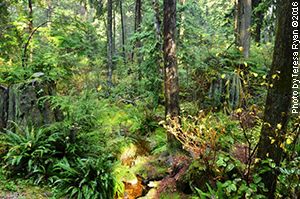
Relatively functioning forest long after old growth was logged, Stanley Park, Vancouver
We would have much more success in our urban areas if trees were planted as communities rather than as individual trees. Our research shows that trees do not behave their best when planted alone, or in a row along a boulevard. Trees are actually part of a community, and there is a synergy between their interactions. Our work shows that though there is competition in the community, there is a lot of cooperation going on below ground: there is sending of signals and sharing of carbon and nutrients for the better of the whole community. We would have better success with our trees—in terms of tree longevity and the ability to attract broader communities of birds and pollinators—if we grew them as communities.
A lot can be done to enhance our urban tree environment by following these basic principles: connection above ground, connection below ground, grow in communities and groups with some kin, and allow regeneration. This would be a huge shift in urban forestry. As we try to green our cities, have them become carbon sinks, and improve hydrology, this kind of approach is key.
The documentary Intelligent Trees briefly featured Dr. Teresa Ryan, an indigenous woman, fisheries scientist, and faculty member at UBC. She spoke with ease of the relationships and interconnectedness of the forest she studies. In what ways has traditional ecological knowledge informed your research?
As far as formally recognizing First Nations and their world view in my early research, no, that was not there. But the way I felt about the environment made me ask the questions that I asked, and that feeling came from my childhood and my experience living in the forest.
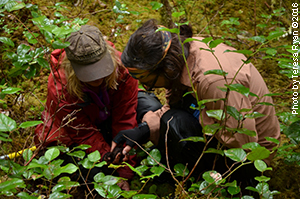
Suzanne with PhD candidate Allen Larocque select research sites in the Heiltsuk First Nation forest
Now that I am older, I have had more and more opportunities to work with First Nations, and that is informing my work. In fact, I just did a TED Talk this weekend about work I’m doing with Teresa Ryan (Tsimshian). We are looking at the links between Aboriginal people on the coast, the salmon fishery, the transfer of marine-derived nitrogen into the forest, and how that affects the forest and cycles back to the streams and the salmon populations. Most of my work is going to focus on those human/forest linkages.
In one of your earlier TED talks, you referred to mycelial networks as “infinite biological pathways that allow the forest to behave as a single organism.” Paul Stamets refers to mycelium as “Earth’s natural Internet” and likens their architecture to that of the human brain. Recent research suggests that oceanic crust may be the largest fungal habitat on the planet. Based on what you have learned so far about fungi, do you think it could possibly be Earth’s neural network?
These fungi are, of course, part of the food web of all of Earth, just like bacteria. There is so much energy below ground, more than we ever thought of or managed for. If you think about half of the energy as being above ground and half as being below ground, that means there is a huge network all over earth. It is pulsing with life. When we look at the physical structure of these below-ground networks, with their hubs, satellites, and links, they do look a lot like neural networks. We have analyzed these networks using neural networks techniques, and there are so many similarities. The fact that our studies show that fungi is ubiquitous across the earth makes it a nice analogy, but I try to be careful with my use of anthropomorphic terms.
To what degree has the work you and others have done to deepen our understanding of the relationships between trees and fungi impacted conservation and forest management?
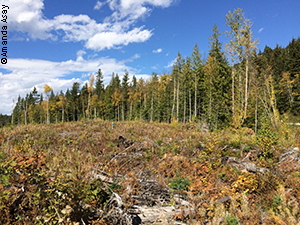
Where I live, and across Canada, the most common forest practice is to clear, cut, and plant. My work shows that you should actually leave clumps of trees because of their networks, and when seedlings link into these networks it helps them establish, and there is a lot of wisdom chemistry that is passed on to new generations through these networks. That has not yet influenced the way we manage forests. The knowledge has been out there in the forestry community but it has not been adopted yet. We still clear- cut, and re-plant. I do think the desire to adopt this knowledge is increasing, however, and that increase seems to be coming from the public rather than from the forestry community.
What do you think is keeping this knowledge from being applied faster?
Economics. Forestry practices are slightly based on ecology, and largely based on economy. A lot of current practices are based on reestablishing a forest quickly and cheaply.
Canada and the U.S. have long had a dispute over soft wood lumber. Americans have rightfully accused Canadians of not paying the full cost of establishing a forest, and therefore selling our lumber more cheaply across the border than America can produce it using better forestry practices. With the Soft Wood Lumber Agreement coming up, I think there is an opportunity to push for changing forest practices.
It’s going to cost a little bit more, but in the long run, at least we’ll have forests that will help us to better deal with climate change.
Most of us grew up assuming that survival of the fittest meant that it was a dog-eat-dog world for trees and other plants. Are trees equal parts competitors and collaborators, or do you think they are primarily collaborators?
There is always a multiplicity of interactions going on between trees that includes cooperation and competition. On very productive sites, trees grow faster and start to compete for light, but at the same time, their roots can become intertwined and connected. At the same time, below ground, they are cooperating by sharing nitrogen, carbon, and water. We tend to simplify things as either/or. The balance of whether it’s more cooperative or competitive depends on the situation and the conditions under which the trees are growing.
Paul Stamets spoke of mycophobia, the fear of fungi because of its invisibility and mystery. Do you think that some of the work you have done and continue to do is turning that around? Do you think we’ll see more interest, more exploration, and more funding of fungi studies?
As part of a big TED event in Vancouver last winter, I did a TED “walk” with a small group of entrepreneurs, architects, and filmmakers. Afterward I was contacted by a fellow who wanted to fund innovative research on carbon storage. He wanted to know what we might be able to do to increase carbon storage below ground. Could we convert desert to fungal factories where we can grow fungi that will suck up carbon and store it below ground? I thought, “Well that’s weird!” and tried to talk to him about the need for healthy ecosystems, plant communities, and forests. He kind of understood, but he could not let go of the idea that there was going to be this amazing innovation involving fungi that was going to save us from climate change. I did not follow up with him because I got busy, but he’s probably doing something with it now, and I think that kind of excitement is really cool. There is a lot of potential to do some very innovative stuff that will be very helpful for how we deal with climate change.
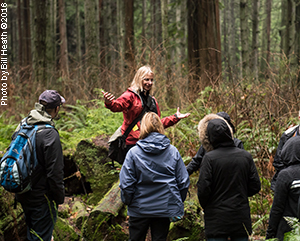
Suzanne at TED Experience Vancouver 2016
Is there anything else you’d like to say to our readers?
Thanks for being so interested, and keep the ideas flowing. It’s in the synergy of everybody who is part of caring for the earth—not just scientists—that we will begin to figure out these complicated problems and come up with ways to enhance the health of our whole ecosystem.

